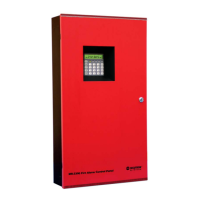45
Indicators, Controls and Operations
Press and hold the LAMP TEST for 3 seconds to show the information about the system and
the firmware version. The first line shows the number of zones and panel type and the second
line shows the software version number.
9.2.5 Buzzer Silence Button
Activation of the Buzzer Silence button while the Buzzer is sounding silences the Buzzer. The
Buzzer will resound if there is a subsequent event. Pressing the button when the Buzzer is not
sounding has no effect.
9.3 Common Relays
9.3.1 Common Alarm Relay
The Common Alarm Relay (labeled ALARM RELAY on the circuit board) activates when a
general alarm sequence is activated. Since all alarm conditions are latched until system reset,
the relay remains on until the alarm is cleared and the system is reset. The Common Alarm
Relay can be disconnected by “Aux Disconnect” (see page 79) if programmed to do so (see
Table 9 Feature Config Menu on page 57.
9.3.2 Common Supervisory Relay
The Common Supervisory Relay (labeled SUPERVISORY RELAY on the circuit board)
activates when the common supervisory sequence is activated as the result of an alarm or any
un-bypassed latching or non-latching supervisory circuit. The relay is turned off if all non-
latching supervisory circuits are restored and there are no latching supervisory circuits active.
The relay can be disconnected by “Aux Disconnect” (see page 79) if programmed to do so
(see Table 9 Feature Config Menu on page 57). This Common Supervisory Relay will function
the same way as a Common Alarm Relay if programmed to (see “12.Common Supervisory
Relay” on page 59).
9.3.3 Common Trouble Relay
The Common Trouble Relay (labeled TROUBLE RELAY on the circuit board) is activated
when the common trouble sequence is activated as the result of the trouble condition being
detected on the system. It is turned off when all troubles are cleared.
9.3.4 Auxiliary Alarm Relay
The Auxiliary Alarm Relay (labeled AUX. RELAY on the circuit board) functions the same way
as the Common Alarm Relay in every respect except that it can be disconnected by “Aux
Disconnect” (see page 79) with or without correlated relays if it is programmed to do so (see
Note: Some troubles are latching once they are detected they remain active until
system reset. In this case the common trouble indicator will also remain active
until system reset. The common trouble is not bypassed by the auxiliary
disconnect function.

